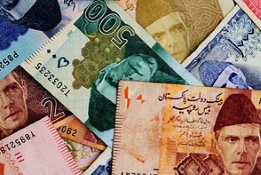Trade Pakistani Rupee Successfully
The Pakistani Rupee is Pakistan’s official legal tender and has the Forex code PKR. The State Bank of Pakistan is the country’s central bank, and it is charged with controlling and issuing the currency as well as setting the interest rates and monetary policies. Most commonly, the symbol used to represent the rupee is Rs, and in Pakistan the currency may be referred to either as “rupees”, “rupaye” or “rupaya”. There are several other currencies in the world known as Rupees. However, these are distinct entities and are separate from the Pakistani Rupee, which is only used in Pakistan and in no other country.
| Broker | Bonus | More |
|---|
The History of the Pakistani Rupee
The term Rupiya originated from the Sanskrit word “rupya” which translates as “coin of silver” or “stamped”. The word Rupaya was first used during the period 1540 to 1545 CE when the coin was introduced by the ruler Sher Shah Suri. The Pakistani Rupee as we know it today was first circulated in the country after the British Raj was dissolved in 1947. At first, British Indian bank notes and coins were used as legal tender with the word “Pakistan” stamped over the face. However, new bank notes and coins were put into use in 1948 for the new Rupee currency. Similarly to the Indian Rupee, the Pakistani Rupee was originally broken down into 16 annas of 4 pice or 12 pie, but in 1961 the currency was decimalised, and the Rupee was instead divided into 100 pice (or paise). No paise coins have been issued since 1994.
Until 1982, the Pakistani Rupee was pegged to the Pound Sterling, but this changed with General Zia-ul-Haq’s government who changed the currency to a managed float. This resulted in a devaluation of the Rupee and an increase in the price of imported materials, which put pressure on the country’s finances. Until the turn of the century, the Pakistani Rupee was depreciated against the US Dollar, but thanks to Pakistan’s large current account surplus the Rupee’s value then began to rise against the Dollar. The exchange rate was then stabilised by the State Bank of Pakistan through the lowering of interest rates and the purchasing of USD to maintain the nation’s competitiveness in the export industry.
Pakistan’s Economy and Economic Factors

The country is in the process of becoming economically liberalised, with privatisation of government corporations taking place in an attempt to attract overseas investment and decrease the deficit in the budget. Although there was hope that the tourist industry would be the next big thing for the country, this has not yet materialised. While about a million tourists have visited the country to see its diverse landscapes and cultures, the numbers of visitors from abroad has gradually declined in recent years due to fears over terrorism. Although the nation’s agricultural industry was once responsible for over half of the country’s GDP, today this share has dropped to around 20% of the economic output, due to the rapid growth that has occurred in sectors such as the service industry (especially finance, transportation, telecommunications and advertising) and the textile, cement and apparel industries.
Which Factors Affect the Economy of Pakistan?
One of the major factors that affect the economy of Pakistan and the value of the Pakistani Rupee is the high level of inflation the country has suffered from for some years, often reaching levels of 26%. Another factor that comes into play when determining the value of the Rupee is political instability in the area. Fears of terrorism and unrest in neighbouring Afghanistan have led to some volatility in the area, and this has had an impact on the country’s economy. International demand for Pakistan’s major exports such as clothing and textiles also has a vital role to play, with the economy receiving a boost whenever global demand is high.


